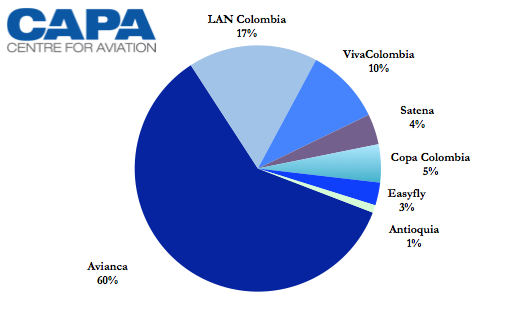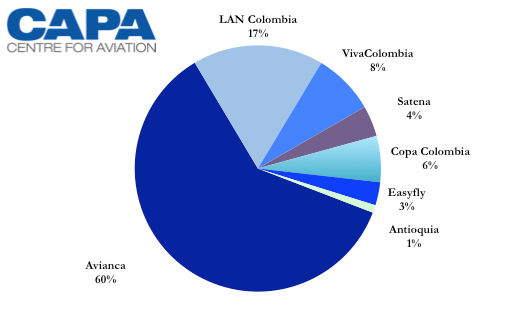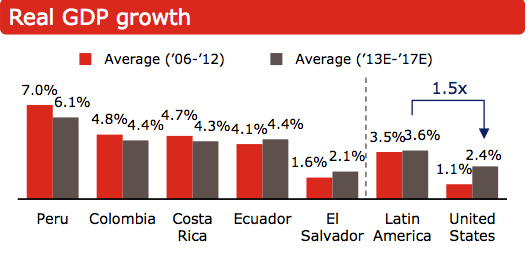Colombia aviation enjoys a rational supply-demand balance even with VivaColombia’s ample growth
Colombia's aviation market appears relatively stable despite the steady growth of the country's low-cost airline VivaColombia through the establishment of a base in Bogota during 2014 in its quest to attain a 20% market share within Colombia.
For the first three months of 2014, VivaColombia's domestic market share grew to approximately 10% from 8% the year prior. The country's other domestic airlines also kept their respective shares at essentially the same levels year-on-year, which shows that the supply and demand balance is fairly rational.
The number of Colombia's international passengers also grew at a solid clip, reflecting the country's overall stability, decent economic prospects and a growing middle class that remains attractive to all airlines serving Colombia.
VivaColombia's capacity increase is underpinned by Bogota expansion
Data from Colombia's CAA show that from Jan-2014 to Mar-2014 Colombia's domestic airlines transported 5.3 million passengers on a total of approximately 6.8 million seats offered. Passenger growth during 1Q2014 in Colombia's domestic market was 5.4% year-on-year, which was in line with 5.4% seat growth resulting in load factors remaining flat at about 78%.
VivaColombia recorded the highest increase in seats offered in the Colombian domestic market during 1Q2014 of 16%. But the airline posted a 28% jump in passengers carried, resulting in a 8ppt increase in load factor to 87%, the highest load factor among Colombian domestic airlines for the first three months of 2014.
One of the drivers in VivaColombia's increase in seat capacity and passenger growth is its establishment of a base at Bogota. At the beginning of 2014 VivaColombia identified several new markets from Bogota, and a search on the airline's website shows that it operates service to four of those markets - Pereira, Santa Marta, San Andres and Monteria.
VivaColombia also operates service from Bogota to Cali, Cartagena, Medellin, Barranquilla and Bucaramanga. It opted to build up Bogota after initially establishing its current base in Medellin and operating on routes that were underserved or had no existing air service. VivaColombia's routes from Medellin include Cartagena, Bogota, Cali, Barranquilla, San Andres and Monteria
See related report: VivaColombia adjusts strategy to focus on Bogota, domestic trunk routes and international services
VivaColombia's passenger and load factor growth appear to reflect some success for the airline in its traffic stimulation strategy, and with overall seat and passenger growth of 5.4% in the domestic market in 1Q2014, its capacity does not seem to be disrupting the market place.
Every airline, with the exception of Copa Colombia (which has turned its focus to international market growth), increased seats on offer year-on-year during 1Q2014 and load factors remained healthy. But LAN Colombia saw a drop in its load factor year-on-year from 76% to 72%.
Seat increase by Colombian domestic airlines: Jan-2014 to Mar-2014
| Airline | Increase in seats
on offer year-on-year 1Q2014 |
| Avianca | 8% |
| LAN Colombia | 6% |
| VivaColombia | 16% |
| Satena | 1% |
| Copa Colombia | (-24%) |
| Easyfly | 4% |
| Antioquia | (-3%) |
The supply-demand balance allowed Colombia's domestic airlines to preserve their respective market share positions in 1Q2014. Aside from VivaColombia's increase and a 1ppt drop at Copa Colombia, each airline essentially retained the same share year-on-year in 1Q2014.
Colombia domestic market share (% of passengers carried) by carrier: Jan-2014 to Mar-2014 vs Jan-2013 to Mar-2013
|
1Q2014
|
1Q2013 |
Colombia's middle class is expected to represent more than half the population by 2020
Colombia's domestic market stability reflects the opportunities available to airlines operating within the country. In its outlook for FY2014 Colombia's largest airline Avianca estimated that Colombia's average GDP growth from 2006 to 2012 was 4.8%, and projects average growth of 4.4% from 2013 to 2017.
Real and projected GDP growth for Avianca's major Latin American markets
Avianca also forecasts that by 2020 the middle class is expected to represent more than 50% of Colombia's population, a 10ppt increase from 41% in 2012.
Projected growth of the middle class in Avianca's major Latin American markets
Publicly, Avianca concludes it is feeling no pressure from VivaColombia, and has stated that VivaColombia's entrance into the market place has actually boosted demand for Avianca's flights. Avianca's domestic load factor remained essentially stable in 1Q2014, dropping 1ppt to 79% on passenger growth of 6%.
VivaColombia's fast rise to Colombia's third largest airline measured by market share shows the effects of its stimulation strategy, and the opportunities for a low-cost airline within Colombia's market. As previously reported by CAPA, VivaColombia can likely charge more for flights from Bogota than its non-Bogota flights, but still offer much lower price points than incumbent airlines in Bogota, driving demand for more frequent trips from Bogota for Colombia's expanding middle class.
Colombia also records strong passenger growth in international markets in 1Q2014
Colombia recorded nearly 11% growth in its international passenger segment in 1Q2014. Market leader Avianca recorded a 4% drop in international passengers carried on flat seat growth.
vianca has readjusted its capacity to Venezuela as the government withholds payments to airlines amidst political and economic turmoil. Avianca has cut its daily service from Bogota to Caracas from seven flights to a single flight. It has warned that the shifting of flights could pressure its results, but believes the capacity it is redeploying from Venezuela back into Colombia and Peru should reach maturity in a six to 12 month time period.
See related report: Airlines in limbo as Venezuela's thorny currency issues persist
LAN Colombia recorded the largest increase in international seats among airlines serving Colombia of 151% but from a low base. The airline has been adding international service during the past couple of years after acquiring Boeing 767s. It currently serves Miami, Sao Paulo and Santiago from Bogota and also added flights to Aruba in 2013.
Despite the capacity expansion year-on-year LAN Colombia held just 4% market share in the international market (measured by passengers carried) during 1Q2014. However it was a 2ppt climb from the 2% share LAN Colombia held the year prior.
Avianca's market share in the international market place from Colombia fell from 41% to 35% year-on-year during 1Q2014 in terms of passengers carried. But the CAA data reports information separately for Aerogal and TACA, which are now all operating under the Avianca brand. Aerogal represented a 5% share in 1Q2014 while TACA represented a 4% share and TACA International had a 2%. So the Avianca Group as a whole has a greater share of the international market than Avianca's separate results reflect.
VivaColombia brings its low fares to new international routes in Aug-2014
VivaColombia marks a new era in its development when the airline launches its first international flights in Aug-2014 from Bogota and Medellin to Panama City Balboa (a former air force base now known as Panama Pacific International Airport). The airline has also said it aims to introduce service from Bogota to Lima. Copa Colombia and Avianca operate service from Bogota to Panama Tocumen, and Copa Colombia flies from Tocumen to Medellin.
VivaColombia's new international service is the testing ground to determine if some of Colombia's busiest international routes are ripe for the airline's stimulation strategy. It is operating daily service from Bogota and four flights a week from Medellin.
Even as VivaColombia is opting to serve Panama through a secondary airport, no low-cost operators serve Panama-Bogota/Medellin, and the routes have some of the highest demand from Colombia, and as previously concluded by CAPA, there is both strong local demand and a high portion of connecting traffic.
With its lower fares VivaColombia should succeed in stimulating traffic on its new international routes. The new service is supported by a sixth Airbus A320 recently joining VivaColombia's fleet after the airline opted not to add aircraft during CY2013. It has set lofty goals for itself, reportedly aiming to transport 2.2 million passengers in 2014, grow to 20% domestic market share and eventually operate a fleet of 50 aircraft.
Colombia is ripe for low-cost stimulation - can VivaColombia deliver?
At this point with a six aircraft operation VivaColombia remains considerably smaller than its Colombian domestic rivals. With so much potential for air traffic growth within Colombia and to/from the country it seems for the moment that Colombia can support a low-cost airline together with other major airlines with a larger scale and different product offering.
Of course the risk is that the supply-demand balance within Colombia could be disrupted, but 1Q2014 growth shows that the market place remains rational.
For VivaColombia the key is keeping its costs low enough to offer fares at price points that stimulate traffic, which allows it to build a passenger base without attempting to steal customers from its larger rivals.
Colombia has all the right elements for a low-cost airline to thrive - a growing middle class, a fairly healthy economy and dominant higher fare airlines. Now VivaColombia just needs to capitalise on that framework consistently with sustained profitability.



